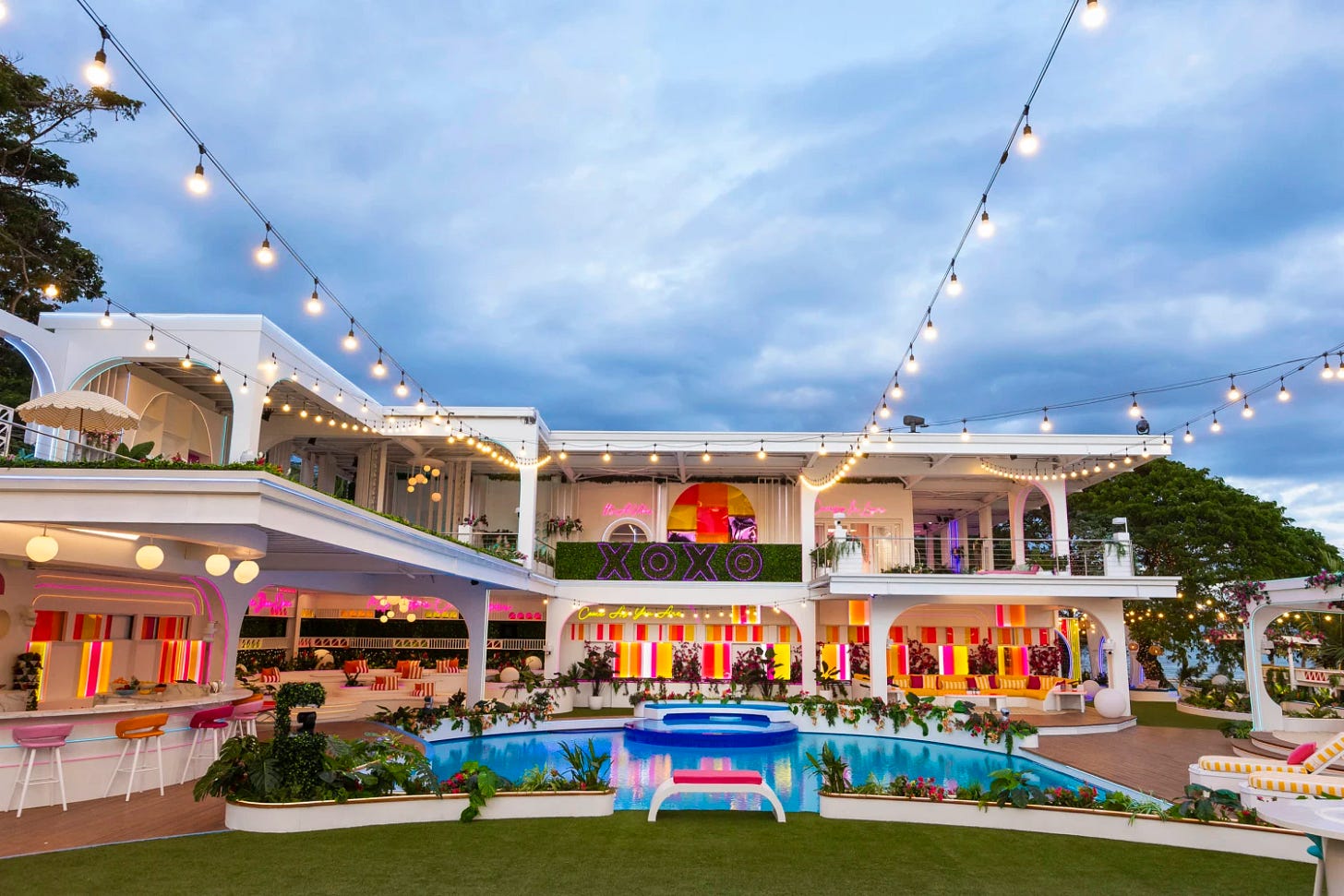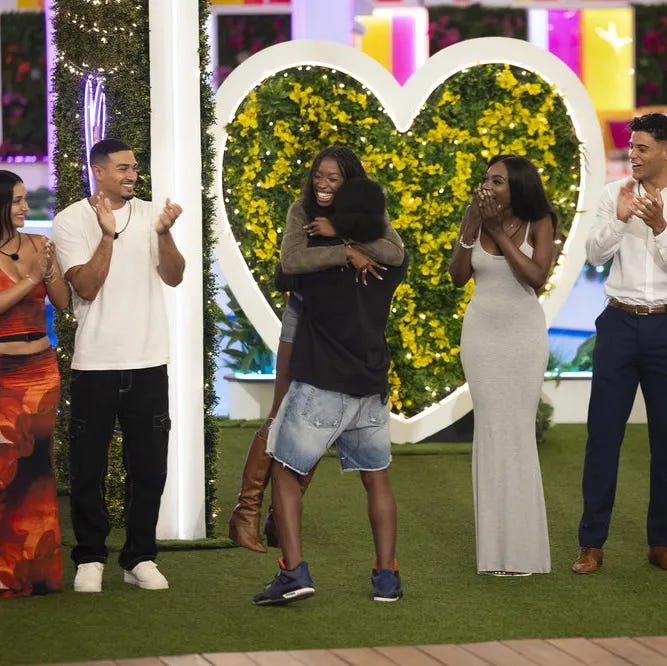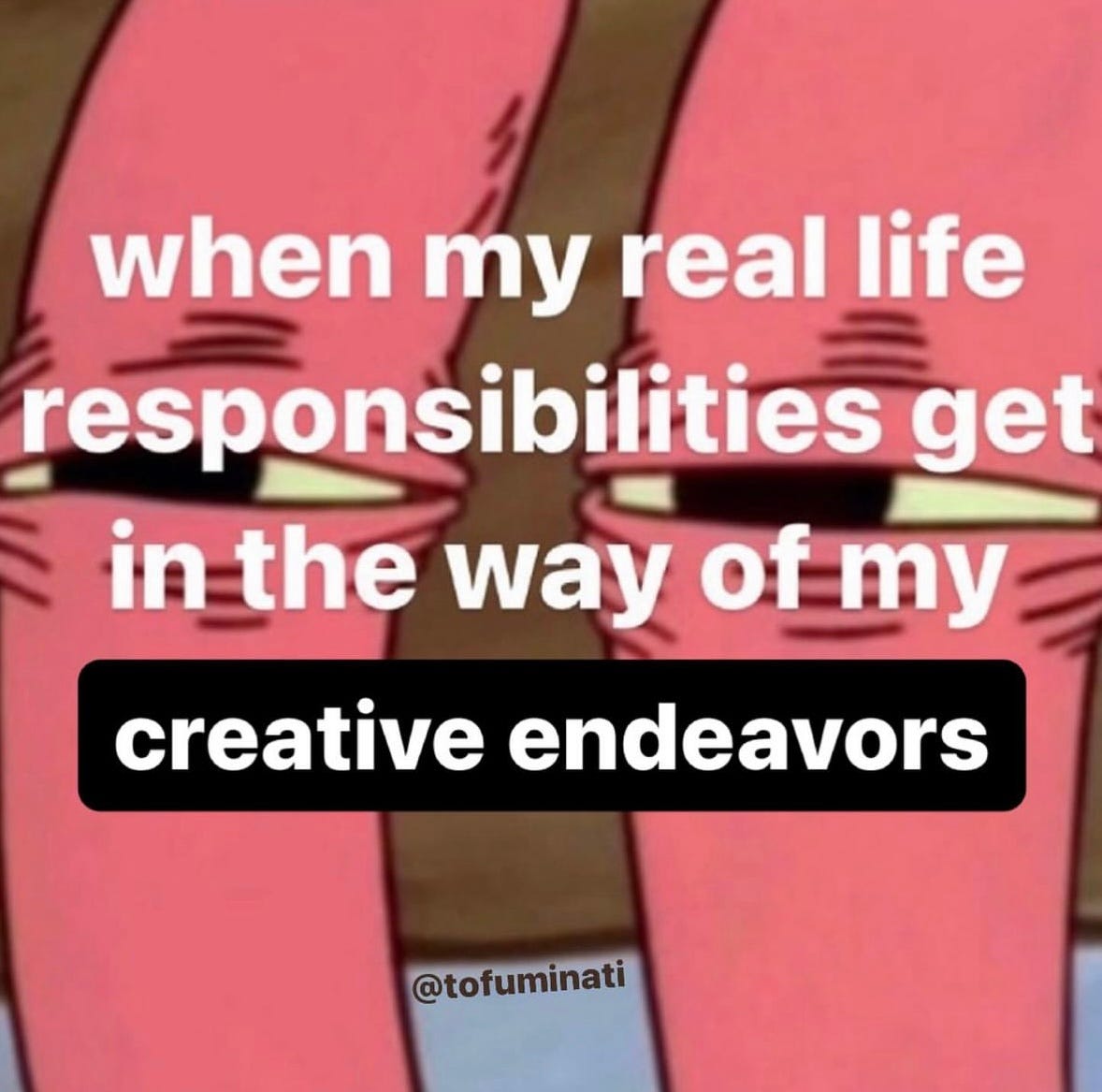Is British slang the new language of love?
Lilly is absolutely buzzing to write about how British slang has become an inextricable part of ‘Love Island’ franchises across the pond. Romance languages, you’ve been dumped from the island.
Like a McDonalds, a Love Island villa is recognizable anywhere. Its Golden Arches are the neon hearts and quippy phrases like “Kiss and Tell” adorning plant walls, the opaque white champagne glasses, the squiggly script used to write the names of contestants on their beds and water bottles. The instantly recognizable over-the-top neon aesthetic of the show is one of the pillars of its success — and the jargon is another.
Like many successful reality shows, Love Island has been able to construct an entire world for its viewers within the confines of its 50,000 square foot villa (which sounds like a lot, but when you consider the fact that they hardly leave for months, it really isn’t much). The Firepit is where beginnings and endings happen, where the current islanders excitedly huddle up and ask bombshells what their type is or tearfully vote off one of their fellow contestants. The Day Beds are where couples spend most of their time, and where they go to tell each other that they’re “open to getting to know one another.” The Bedroom, a long narrow room with a row of identical labeled beds, is where islanders see their value on display, sleeping happily cuddled up or painfully alone. The strong sense of place created by the villa allows the show to be successfully placeless, set against tropical beach backdrops across the globe.
Of course, the world building of Love Island extends far past the physical markers. There are hidden rules all contestants know to follow by now. For example, a good male partner on Love Island brings his girl the scariest looking avocado toast you’ve ever seen and an iced coffee every morning — even if he doesn’t like them. An islander on the show “for the right reasons” (aka, to find love, cash prize and fame aside) will open themselves up to every other contestant to “test” their current couple. “Challenge kisses” don’t count, but villa kisses do. Asking someone to be your girlfriend or boyfriend should be an elaborate performance, requiring scavenger hunts, surprise parties, and plated dinners, and should be met with standing ovations from the rest of a villa. Contestants who don’t play ball risk being voted out, whether by the public or their fellow islanders.
…
…
It all sounds ridiculous out of context, but in a show where the majority of time is spent laying outside for up to 7 hours a day, talking to the same small group of people, these symbols drive the plot. It’s the kind of structure necessary to elevate the low stakes drama — who had a chat with who? where? for how long? — into a smash hit TV show. And it is, by all counts, a smash hit.
Love Island was started by the British production company iTV in 2015 — as a distinctly UK show. It was based on its failed predecessor, Celebrity Love Island, which featured a range of small time to slightly less small time UK celebs like Irish nightclub owner and former boyband bodyguard Fran Cosgrave and singer Liz McClarnon of the girl group Atomic Kitten. On average, about half a million viewers watched the reboot in its first year. The number tripled by the next year’s series, then almost doubled again — a hefty viewership for a show that typically airs over 40 episodes, with a near-daily release schedule. By 2024, 22 versions of it have been released (double the number of the Real Housewives series, one of the most popular reality franchises in the U.S.). There’s enough content to have had a Love Island meets The Challenge spinoff with Love Island Games (featuring contestants from around the world) as well as an All Stars season.
While islanders speak in their own native tongues in each international franchise, production didn’t need to change much to adapt to the different countries. The Love Island culture was already its own, separate entity, able to transcend cultural borders. The consistency in the vibrant set design, the reliance on invented relationship milestones, and the use of language is proof of a formula that works across the world. For Love Island USA, which Peacock recently announced as the most-watched streaming series in the U.S. — British slang is a distinct part of that formula.
Americans have had other touchstones for British culture — double-decker buses and red phone booths, One Direction, Prince Harry — and we’ve used British culture to inspire our own before, like with The Office. Not to mention, the 2010s internet had such a serious case of anglophilia that it had random suburban middle schoolers (read: me) wearing a union jack t-shirt most days of the year (not weather-dependent) and practicing a posh accent while watching British girls do Primark hauls on YouTube. However, we’ve never started speaking the language. In fact, American slang has tended to control global youth culture. In an article on PBS NewsHour, linguistics professor Jannis Androutsopoulos makes this argument using the pervasiveness of American slang in German youth cultures as one example. “Slang’s main social function is to signal belonging: American slang marks the speaker or writer as an active and informed member of global youth culture,” he writes. “Through the media, young people enter fan communities where they learn to incorporate certain forms of English into both their speech and writing to show that they’re a part of youth culture. As a result, American slang and related resources have become a global code for youth worldwide embedded in a local code — the national language.”
On the most recent season of Love Island, though, we see that many British speaking patterns and slang terms have made their way across the pond. The U.S. contestants use the language of the U.K. to signal their belonging to the global Love Island culture: Islanders with deep Pittsburgh or Valley Girl accents like season 6’s Kaylor and Leah ask the men on the show to “have a chat.” In the dressing room, the girls reassure each other that they aren’t being “mugged off” by their male partners. When a US islander is feeling good about their relationship, they’re “absolutely buzzing.” If two islanders are connecting, they’re “ticking each other’s boxes” and when girls are turned on, they get the “fanny flutters.” It’s a use of slang that would sound completely unnatural outside of the bounds of the Villa, but makes total sense on the screen. Notably, the U.S. contestants lean into British slang when they’re playing the game of Love Island and signifying important relationship milestones. They revert back to their natural American slang when discussing their feelings intimately with their partner. One example is when Kordell tells Serena he really “fucks with her” in a sweet moment during their final date. In that way, British slang is a central ingredient to Love Island jargon for fans and islanders (especially since the U.S. islanders are, for the most part, fans of the original British show).
It’s important to note, though, that we don’t love Love Island because we love the Brits or their way of speaking (as evidenced by the U.K. franchise’s dip in ratings lately). We love it because, despite the different castmates and new twists introduced each season, we know what to expect — like any great fast food product. It allows us to escape into an alternate universe, parallel to reality, where contestants have no idea that there was an assassination attempt in the U.S.; their primary concern is who in the villa has the best banter. In the Villa, portrayed in the show as the exact opposite of “the outside,” the phones only take pictures, the sun is always out, the people are always beautiful. Language doesn’t follow standard conventions here because, with everything else so technicolor and abstracted from reality, why would it? The Brits may have created this neon BarbieLand, but it’s expanded far past their reach. What makes the engagement with British culture and language on Love Island unique is that, because of the strong branding of the show, it’s been divorced from the UK entirely. It’s become the language of Love Island, and for dozens of contestants each year, the language of love. — LM
Mama let’s research
Find further reading and resources on this week’s topic below!
“The Global Spread of American Slang” by Jannis Androutsopoulos - PBS NewsHour — If you’re interested in learning more about the basics of slang and how American slang has become the predominant language of youth culture around the world, this is a good starting point.
“Love Island Is My True Crime” by Lilly Milman - This is Why! — Call me corny, but I really have to plug my other Love Island essay here. In this piece, I talk about why women are drawn to reality dating content in the same way they’re drawn to true crime content.
“The ‘Love Island’ Dictionary” by Andrew Gruttadaro - The Ringer — If you want to learn more about the actual slang of Love Island, this is another great primer, covering all the British slang we’ve grown to love on the original show.
“📍Soul Ties” by Hunter Harris - Hung Up — New Love Island fan and funniest person on Substack
ranks every cast member from Love Island USA season 6. What’s not to love?
Hunter-gatherer corner
What we’ve read and DMed each other about lately — our internet bounty is below!
“Meet the queen of the ‘trad wives’ (and her eight children)” by Megan Agnew - The Times — I’ve shared a lot of trad wife content on here, but this is the best article I’ve read on the subject. It follows Hannah Neeleman, the creator behind the viral homesteading account Ballerina Farm, as she attempts to complete an interview despite the constant interruptions from her husband and children. Agnew masterfully paints a picture of the family by highlighting the interruptions, almost as if they are their own character in the piece. A must read! — LM
Are You Ready, Kids? by Maya Phillips and Sean Catangui - The New York Times — This Spongebob anniversary quiz was cute (I mostly aced it, but I was surprised at the questions that tripped me up!) Sorry to anyone who’s parents didn’t let them watch Spongebob “because it makes you stupid.” You missed out big time. —MF
Why Not?
Why Not? is our biweekly list of recommendations. Think recipes, gift guides, podcasts, clothes, and anything we consider to be generally chic. Have a suggestion? Let us know!
Blu Dot furniture — We Facebook Marketplaced most of our furniture in our new place, but decided to buy a couch, rug, bed frame new. The couch and bed came from Blu Dot and I was so impressed with the quality and the service! Delivery was fast (like within 3 weeks of ordering fast — which, for a new couch, is incredible) and their crew set everything up inside the right rooms for us. Highly recommend! — LM
Lekker Home — While the brand of furniture I bought was from Blu Dot, the store I worked with was Lekker Home in the South End of Boston. I was struggling to decide on a couch and rug combo and the free design consultation with Lekker was so helpful in figuring out what colors would work for my new living room. Plus, doing a design consultation (albeit a free one!) felt super luxurious. — LM
Hanky Panky underwear - Miami Sample — It’s probably time for your bi-yearly underwear drawer clean out (this is not a real required event, unless you’re like me in which your cycle has drastically changed and your laundry machine is eating your favorite pairs and you also still have those Victoria’s Secret panties from ninth grade somehow despite the aforementioned bi-yearly drawer clean out.) Recently a man asked me to guess how much a 3-pack of Calvin Klein underwear should cost and I correctly guessed $50, which was a lowball on my part. All that is to say, lots of “good underwear” brands are scammily priced; you have to wait to pounce. Here are some no nonsense offerings that I often see recc’d on Reddit, for a pretty good price. —MF
If you liked this issue, take us to Soul Ties! Tell us your thoughts in the comments or on Instagram (@lilly_milman | @melindafakuade), and share it with your strongest connection.







